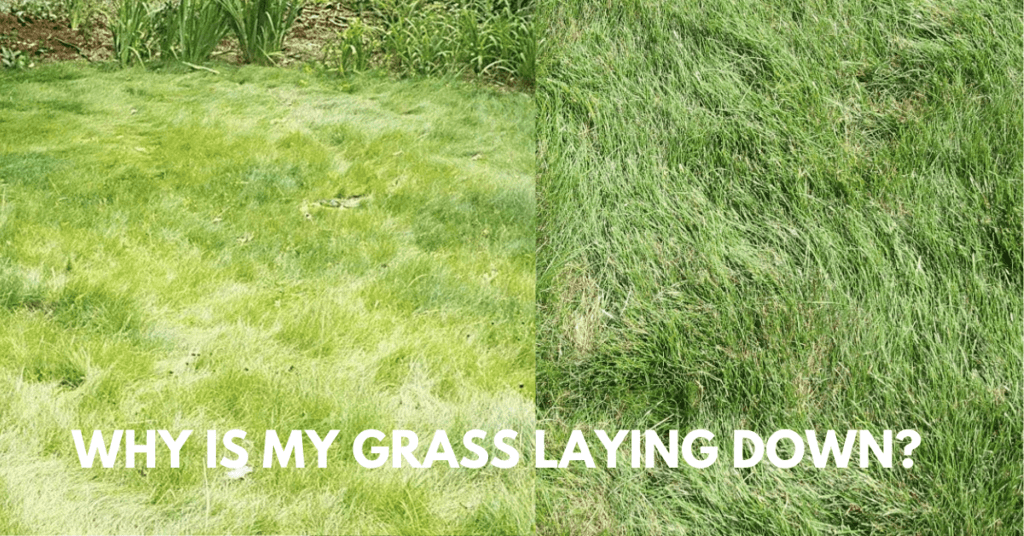Taking care of your lawn is a task that requires dedication and commitment. Despite all of your best efforts, you may notice that your grass starts to appear flat and leaves you wondering what you can do to fix it.
There are a few reasons why your grass may be laying down, and in this article, we’ll take a closer look at what you can do to rectify the problem.
Reasons for Laying Down Grass

Heavy Cut of Grass (Mowing)
One of the most common culprits behind a lawn that’s laying down is a heavy cut of grass.
When you mow your lawn with a mower that has dull blades or that cuts the grass too short, the blades can tear or damage the grass, causing it to flatten or lay down.
This is why it’s important to keep your mower blades sharp and to mow your lawn at the proper height.
Over-Watering
Over-watering your grass can cause it to become waterlogged and heavy, which can lead to it laying down.
When you over-water, the grass roots can become waterlogged and unable to draw in the oxygen they need to thrive.
This can cause the grass blades to wilt or lay down. Make sure to water your lawn deeply and infrequently to encourage healthy root growth and to avoid over-watering.
Poor Grass Stand
Grass stand refers to the density and quality of the grass on your lawn. If your grass stand is poor, it can cause your grass to lay down.
Thin and weak grass stands are more susceptible to flattening under their weight.
To improve your grass stand, consider aerating your lawn, planting new grass seed, or installing new sod.
Improving and Maintaining Grass Stand
Using Soil Amendments
Soil amendments can help to improve the quality of your soil and promote healthy grass growth.
Adding compost, topsoil, or fertilizer to your lawn can provide crucial nutrients to your grass and help to keep it lush and healthy.
Lawn Mowing Tips
Proper mowing is essential for maintaining a healthy grass stand. Make sure your mower blades are sharp and that you’re mowing at the appropriate height for your grass type.
Try to mow your lawn in different directions each time you cut it to prevent grass from laying down in one direction.
Selecting the Right Type of Grass
Different types of grass are better suited for different climates and soil types.
Before planting new grass, make sure to research the type of grass that’s best for your area. This will help to ensure that your lawn stays healthy and lush all year long.
Steps to Repair Damaged Grass
Adding New Sod or Seed to Your Lawn
If your grass is damaged and laying down in patches, you can repair it by adding new sod or seed to your lawn. This will help to fill in any bare spots and encourage new, healthy grass to grow.
Preventative Measures for Compacted Soil
Compacted soil can prevent your grass from getting the air, water, and nutrients it needs to grow properly.
To prevent soil compaction, try aerating your lawn once or twice a year. This will help to loosen the soil and allow your grass roots to breathe.
Use of Fertilizer and Nutrients
Fertilizer and nutrients can help to provide your grass with the necessary nutrients it needs to grow and thrive.
Make sure to fertilize your lawn regularly to help keep it healthy and to avoid over-fertilizing, which can lead to too much growth and make your lawn more susceptible to damage.
How to Deal with Potentially Harmful Pests and Weeds
Pests and weeds can damage your lawn and cause it to lay down. To prevent this, use preventative measures such as using weed killer, insect repellent, and removing weeds as soon as you see them.
Conclusion
In conclusion, there are several reasons why your grass may be laying down. From improper mowing techniques to poor grass stands, there are many factors that can contribute to this issue.
By using the proper lawn care techniques and taking preventative measures, you can help keep your lawn healthy and upright.
And if your lawn does become damaged, repairing it with new sod or seed, aerating your lawn, and providing it with the proper nutrients can help it grow back stronger than ever.
Remember that caring for your lawn is an ongoing process, so always monitor for any signs of distress and customize your lawn care routine accordingly.
